The Sailplane Market is estimated to be valued at USD 301.0 billion in 2025 and is projected to reach USD 423.8 billion by 2035, registering a compound annual growth rate (CAGR) of 3.5% over the forecast period.
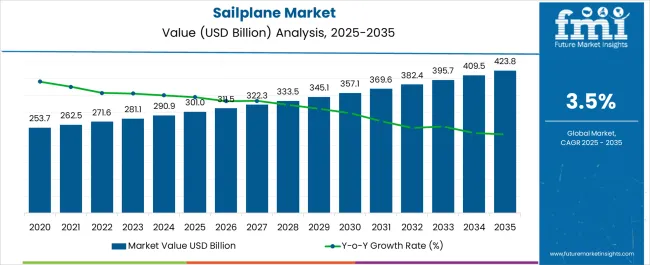
| Metric | Value |
|---|---|
| Sailplane Market Estimated Value in (2025 E) | USD 301.0 billion |
| Sailplane Market Forecast Value in (2035 F) | USD 423.8 billion |
| Forecast CAGR (2025 to 2035) | 3.5% |
The Sailplane market is experiencing notable growth driven by rising interest in recreational aviation and the increasing popularity of sports and leisure flying activities. The future outlook for this market is shaped by the growing emphasis on sustainable aviation technologies and the adoption of electric-powered propulsion systems. Increasing investments in pilot training programs, flying clubs, and leisure aviation infrastructure are supporting market expansion.
The shift toward environmentally friendly and noise-reduced aircraft is encouraging the use of electric-powered sailplanes, which offer both operational efficiency and reduced ecological impact. Additionally, the growing participation in gliding competitions and adventure sports has elevated the demand for high-performance sailplanes.
Technological innovations in lightweight materials and aerodynamics are further enhancing flight efficiency and safety, making sailplanes more attractive to both amateur and professional pilots As recreational aviation becomes more accessible and government regulations support sport flying, the Sailplane market is anticipated to witness steady growth, with opportunities emerging in both mature and emerging regions.
The sailplane market is segmented by number of seats, power source, end use, and geographic regions. By number of seats, sailplane market is divided into Single Seater and Double Seater. In terms of power source, sailplane market is classified into Electric Powered and Gasoline Powered. Based on end use, sailplane market is segmented into Sports & Leisure Activity and Military. Regionally, the sailplane industry is classified into North America, Latin America, Western Europe, Eastern Europe, Balkan & Baltic Countries, Russia & Belarus, Central Asia, East Asia, South Asia & Pacific, and the Middle East & Africa.
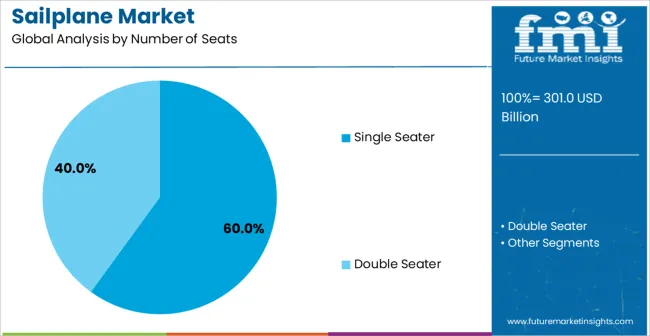
The single-seater segment is projected to hold 60.0% of the Sailplane market revenue share in 2025, establishing it as the leading configuration. The growth of this segment has been influenced by the preference for individual flying experiences in sports and leisure activities, which allow pilots to gain greater control and personal satisfaction.
Single-seater sailplanes are favored for training, competition, and recreational purposes due to their lighter weight, enhanced maneuverability, and ease of handling. The design flexibility of single-seater aircraft supports the integration of advanced cockpit instruments and aerodynamics features, improving performance and safety.
Moreover, single-seater sailplanes are more cost-effective in terms of maintenance and operational expenses, which encourages adoption among private pilots and flying clubs The segment’s prominence is further reinforced by the growing demand for personalized aviation experiences and competitive gliding sports, which continue to drive sales and market share growth.
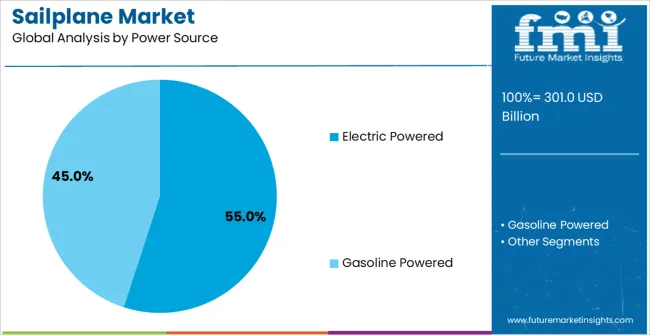
The electric-powered segment is expected to capture 55.0% of the Sailplane market revenue share in 2025, making it the leading power source type. The adoption of electric propulsion has been driven by the growing focus on environmental sustainability and the reduction of carbon emissions in aviation. Electric-powered sailplanes offer quieter operation, lower maintenance requirements, and improved energy efficiency compared to traditional combustion engines.
These benefits have made them increasingly preferred in sports, leisure, and training applications. Additionally, technological advancements in battery capacity and motor efficiency have enhanced flight duration and reliability, supporting wider acceptance of electric-powered models.
The rising regulatory emphasis on clean energy adoption and the promotion of green aviation initiatives are further contributing to the growth of this segment As pilots and clubs prioritize sustainable and cost-effective flying options, the electric-powered sailplane segment is expected to maintain its leading position in the market.
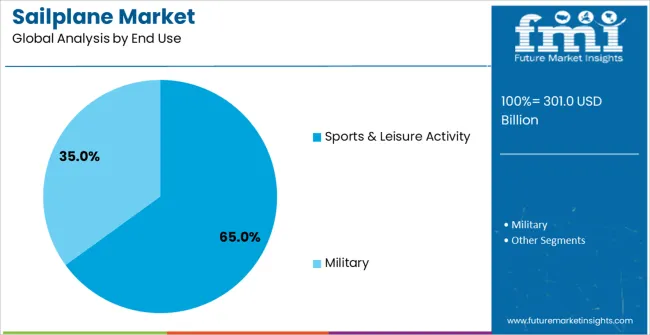
The sports and leisure activity segment is anticipated to account for 65.0% of the Sailplane market revenue in 2025, positioning it as the dominant end-use industry. This growth is driven by increasing recreational interest in gliding, adventure tourism, and competitive flying events. Sailplanes offer unique experiences that combine skill development, thrill, and environmental consciousness, which has amplified their popularity among enthusiasts.
The ability to engage in individual or group flying activities with minimal environmental impact has made sailplanes attractive for both private owners and aviation clubs. The segment’s growth is further supported by the expansion of leisure aviation infrastructure, such as gliding centers, flight schools, and sporting associations, which facilitate accessibility and training opportunities.
Additionally, the development of electric-powered and high-performance sailplanes has enhanced safety and flight efficiency, increasing adoption within sports and leisure applications As the demand for recreational aviation continues to rise, the sports and leisure activity segment is expected to remain the primary driver of the Sailplane market.
A sailplane is a type of a glider aircraft generally used in the sports and leisure activity. The sports of flying sailplane is referred to as soaring. Sailplane is an aerodynamically designed aircraft developed with a high lift-to-drag ratio.
According to the Federal Aviation Administration, sailplane is defined as a heavier-than-air fixed-wing aircraft which is supported by the dynamic reaction of the air against its lifting surfaces during flight, and is not principally dependent on an engine.
A sailplane is designed to fly and gain altitude from the natural force such as thermal and ridge lift. Sailplanes are also equipped with engines to sustain and enable the level flight in area of descending air flow. The overall performance of the sailplane primarily depends on the various design parameters such as aerodynamic efficiency, flight mechanics, material used, aircraft structure, etc.
Sailplanes are generally made from made of lightweight high strength materials such as carbon fiber or glass fiber. Sailplanes are predominantly used in the sports and leisure activity and military applications. In military sailplane are used train cadets the fundamentals of flights.
Further, the advancement in computational methods and development of modern aerodynamic concept are some of the key factors aiding sailplane manufacturers to improve overall performance and increasing the lift to drag ratio.
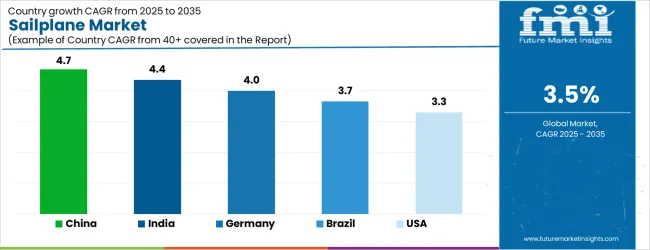
| Country | CAGR |
|---|---|
| China | 4.7% |
| India | 4.4% |
| Germany | 4.0% |
| Brazil | 3.7% |
| USA | 3.3% |
| UK | 3.0% |
| Japan | 2.6% |
The Sailplane Market is expected to register a CAGR of 3.5% during the forecast period, exhibiting varied country level momentum. China leads with the highest CAGR of 4.7%, followed by India at 4.4%. Developed markets such as Germany, France, and the UK continue to expand steadily, while the USA is likely to grow at consistent rates. Japan posts the lowest CAGR at 2.6%, yet still underscores a broadly positive trajectory for the global Sailplane Market. In 2024, Germany held a dominant revenue in the Western Europe market and is expected to grow with a CAGR of 4.0%. The USA Sailplane Market is estimated to be valued at USD 108.2 billion in 2025 and is anticipated to reach a valuation of USD 108.2 billion by 2035. Sales are projected to rise at a CAGR of 0.0% over the forecast period between 2025 and 2035. While Japan and South Korea markets are estimated to be valued at USD 14.7 billion and USD 7.7 billion respectively in 2025.
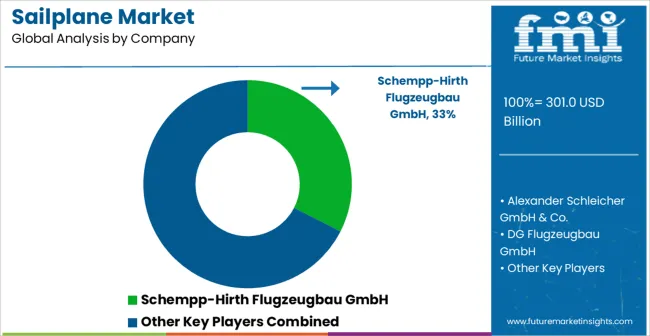
| Item | Value |
|---|---|
| Quantitative Units | USD 301.0 Billion |
| Number of Seats | Single Seater and Double Seater |
| Power Source | Electric Powered and Gasoline Powered |
| End Use | Sports & Leisure Activity and Military |
| Regions Covered | North America, Europe, Asia-Pacific, Latin America, Middle East & Africa |
| Country Covered | United States, Canada, Germany, France, United Kingdom, China, Japan, India, Brazil, South Africa |
| Key Companies Profiled | Schempp-Hirth Flugzeugbau GmbH, Alexander Schleicher GmbH & Co., DG Flugzeugbau GmbH, Jonker Sailplanes (Pty) Ltd, Pipistrel d.o.o. Ajdovščina, Lange Aviation GmbH, Stemme AG, and LZ Design |
The global sailplane market is estimated to be valued at USD 301.0 billion in 2025.
The market size for the sailplane market is projected to reach USD 423.8 billion by 2035.
The sailplane market is expected to grow at a 3.5% CAGR between 2025 and 2035.
The key product types in sailplane market are single seater and double seater.
In terms of power source, electric powered segment to command 55.0% share in the sailplane market in 2025.






Full Research Suite comprises of:
Market outlook & trends analysis
Interviews & case studies
Strategic recommendations
Vendor profiles & capabilities analysis
5-year forecasts
8 regions and 60+ country-level data splits
Market segment data splits
12 months of continuous data updates
DELIVERED AS:
PDF EXCEL ONLINE

Thank you!
You will receive an email from our Business Development Manager. Please be sure to check your SPAM/JUNK folder too.
Chat With
MaRIA